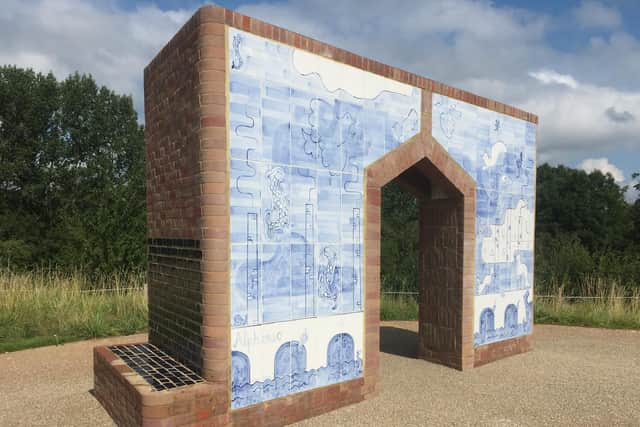New 9ft tall folly to be unveiled at lakeside in Milton Keynes this week
and live on Freeview channel 276
A new 9ft tall public folly called Alphonso is be be unveiled at Newton Leys on Saturday.
The £100,000 work, called Alphonso, has been created by artist Sarah Staton, and takes pride of place by Willow Lake.
Advertisement
Hide AdAdvertisement
Hide AdPaid for by property developers on the estate, it takes inspiration from its local heritage and has tiles depicting the local area and its wildlife and history.


Saturday will see a public celebration where families can meet the artist, learn about the sculpture's local inspirations and enjoy refreshments provided by MK Council.
Alphonso is the most recent addition to the council's ongoing ambitious Public Art commissioning programme, which has commissioned more than 250 artworks since 1960.
It is a triangular, three-sided structure built from wood-fired brick and incorporates a bespoke hand-painted image inspired by Azulejos tiling.
Advertisement
Hide AdAdvertisement
Hide AdIt includes a decorative archway and seating area, which overlooks the lake and the environment around it.
London-based artist Sarah has included elements that would appeal to various age groups. There are pictures and textures for children, an archway to pass through, and a small bench for residents and visitors to enjoy the views.
She worked closely with the Newton Leys Public Art Commission Steering Group when developing the work. The process involved a visit to Rushton Lodge, a triangular folly designed by Sir Thomas Tresham in the 14th Century, as well as H.G. Matthews, which supplied the bricks for the artwork.
One essential part of the commission was to reference the brick-making history of Newton Leys and how it is today.
Advertisement
Hide AdAdvertisement
Hide Ad"Early on in the design process, I thought Alphonso would look most interesting if handmade bricks were used on the east elevation, creating a richly nuanced speckled brown surface, and that this would be complemented with fresh blue and white tiles on the west side," said Sarah.
"The lake is referenced pictorially. I had been very struck by the way that blue and white tiling is used on cathedrals and churches in Portugal to create the illusion of transparency when viewed from a distance against the sky."